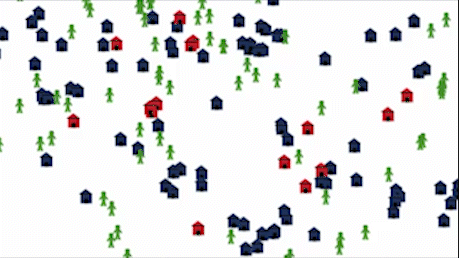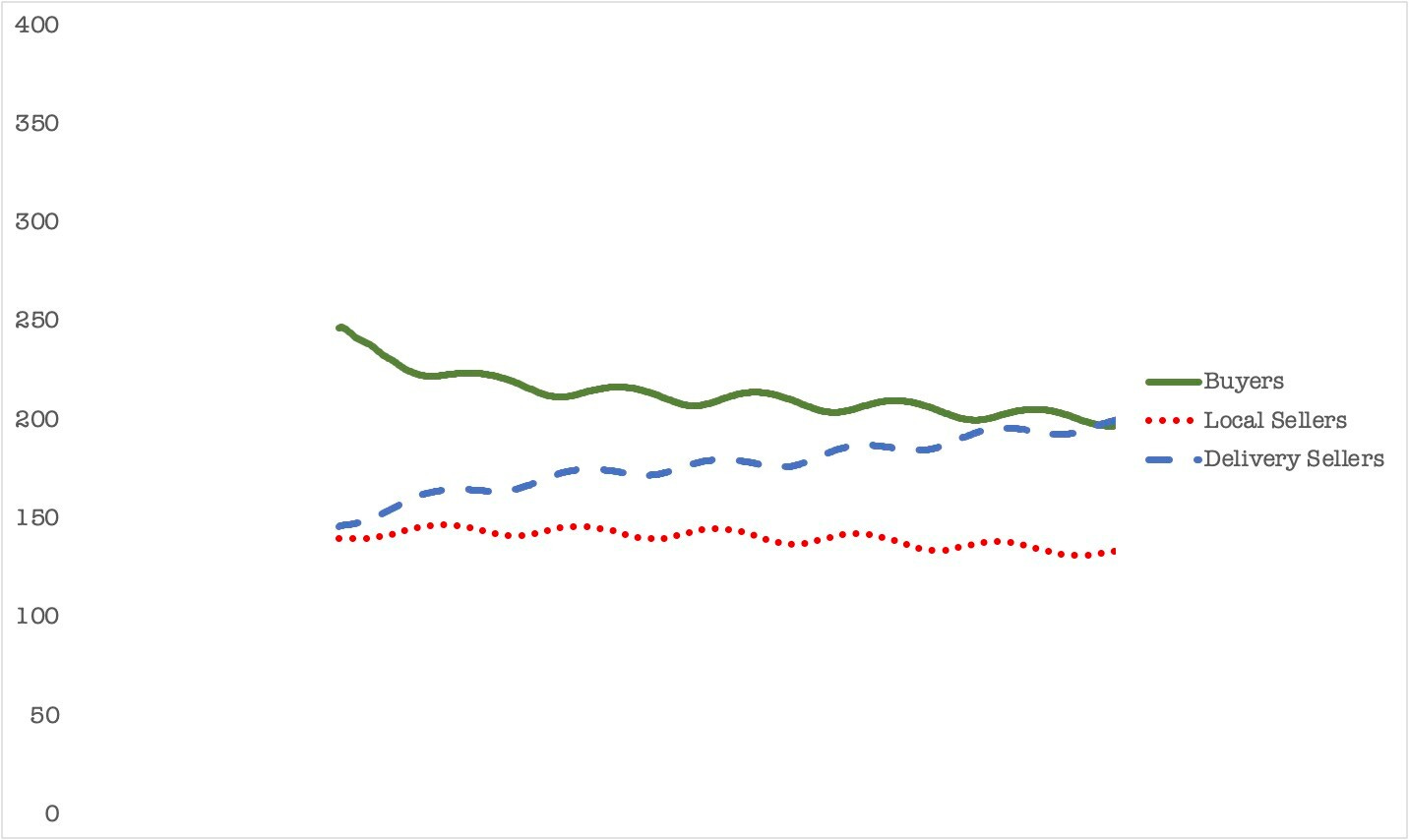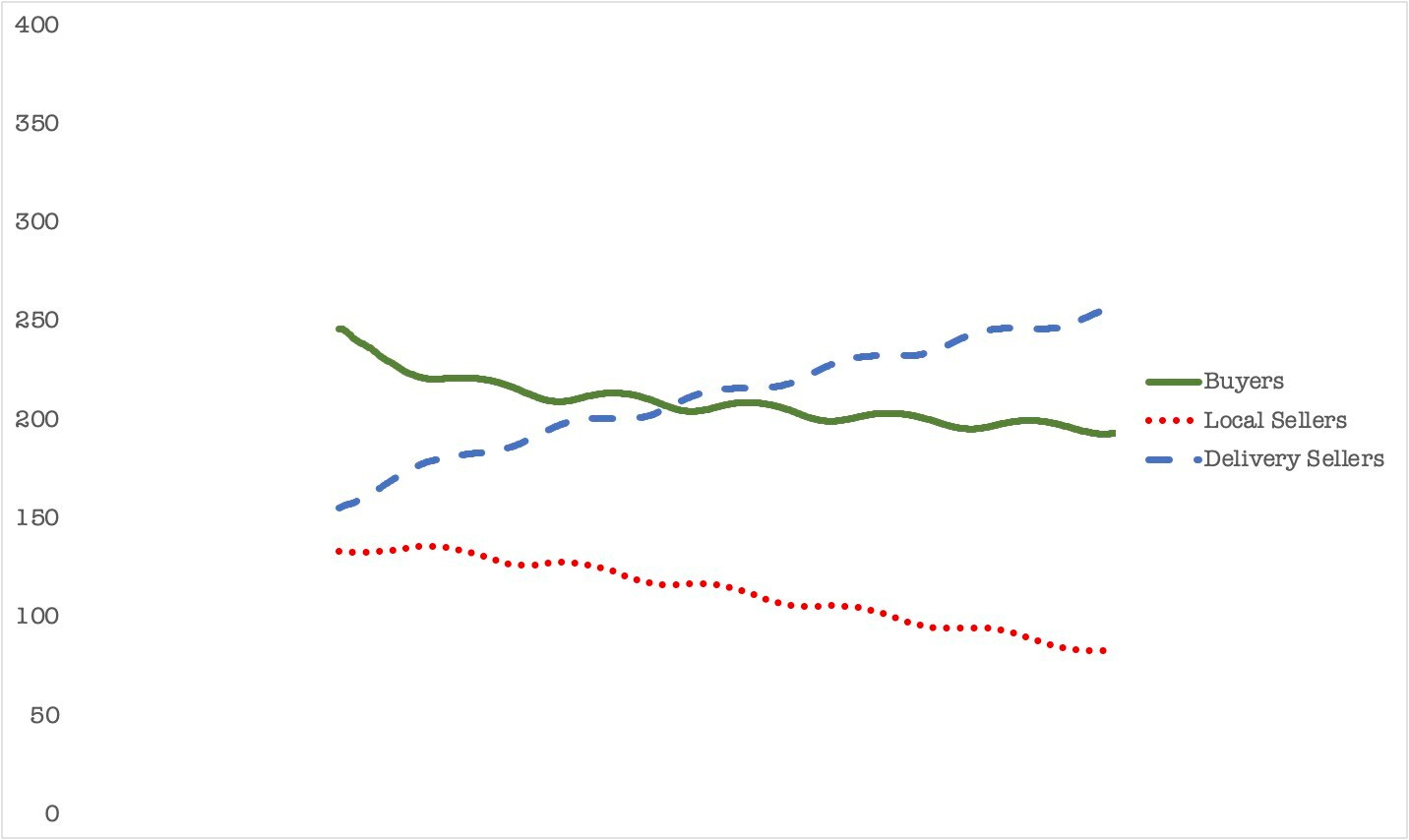Two-sided Marketplace Dynamics: Insights from Agent-Based Modelling Approach
Having worked for the Marketplaces businesses for the past 15+ years, I was always keen to understand the dynamics of two-sided marketplace over time and how modelling insights can help steering it towards a healthy and sustainable ecosystem.
Successful marketplaces have tens of millions of active users, and modelling aggregate user behaviour by looking at the averages tends to be more descriptive (i.e. “an average buyer comes back 4 days a month and is successful 25% of the time”) than actionable (i.e. “adding 100 more sellers will increase average buyer’s success by 10ppt”).
It is especially challenging to forecast the dynamics of such large system beyond extending the known long-term trends. This is where agent-based modelling approach can bring forward-looking insights for marketplace interventions, where past averages are not enough to understand the future scenarios.
For example, it’s possible to run simulations of how a marketplace evolves if a large group of business sellers are added to a C2C category. Or investigate how introducing pay-and-ship transactions affects the dynamics of buyer success and overall marketplace health.
I illustrate this below with a few examples, using Netlogo ABM Modelling suite from the Center for Connected Learning and Computer-Based Modelling at Northwestern University and building upon its evolutionary biology models.
What is a Healthy and Sustainable Marketplace?
The drivers of a healthy two-sided marketplace are known: a richer offering and better matching lead to more happy buyers, who in turn come back to the platform, attracting even more sellers and further enriching supply, and leading to even more successful transactions – the classical flywheel.
A healthy two-sided marketplace has:
- many diverse sellers and items on offer
- many potential buyers with a purchase intent
- high probability of matching demand and supply
- smooth transacting experience.
A sustainable two-sided marketplace has:
- growing number of sellers, buyers, and successful transactions
- overall profitability and a sustainable margin outlook.
Ideally, the growth levers (sellers, buyers, and transactions) come with a positive unit economics, making the marketplace self-sustainable. In real life, this is hard to quantify upfront.
First, there is a time gap between the investment (into marketing, customer acquisition, new product feature) and the return (lifetime value of the customer or the ROI on the product). Second, the complexity of the overall ecosystem makes it hard to single out cause / effect of a specific lever or its long-term consequences.
This is where agent-based modeling can be especially insightful, since it allows generating multiple scenarios for complex system dynamics and observing how parameter change affects both the over-time dynamic and the long-term equilibrium.
Example - Local Pickup vs. Delivery Marketplace Dynamics
Let’s illustrate this with a simple example that builds upon the evolutionary biology models.
Imagine a marketplace with two types of sellers: Local Pickupsellers make their goods available within a certain (small) radius, while Delivery-Enabled sellers can reach a wider audience with their goods. Buyers are equally likely to consider either seller but might get different benefits from using a pick-up vs. a delivery solution (more on this below). What are different dynamics when different parameters are considered?
I modified a Bug Hunt Predator Invasive Species model from the Netlogo Library to reflect the following assumptions:
Marketplace Model
Local-pickup and Delivery-enabled sellers earn money from the market demand and spend money on the marketplace presence.
Sellers with more money increase their presence.
Total market demand is constrained and can sustain a finite number of sellers.
Buyers roam the marketplace and get matched with sellers randomly.
Buyers get value from transactions, and they invite new buyers to the marketplace when the value is high.
Bug Hunt Predator Invasive Species Model
Two types of insects live in the field and gain energy from eating grass and spend energy on roaming the field.
Insects with enough energy reproduce.
Total amount of grass and its regrowth rate are constrained and can sustain a finite number of insects.
Birds fly over the field and eat insects randomly.
Birds gain energy from eating insects and reproduce when the energy is high.
Then I ran 200 simulations of 1,000 iterations each to observe marketplace evolution under different seller and buyer characteristics. The key question remains – what constitutes a healthy and sustainable marketplace? What ensures a lively market with many diverse sellers, many buyers and transactions, and with a stable overall population dynamic? And what leads a marketplace go into decline?
Below are a couple of examples that show the potential of this approach.
When the ability to reach buyers and the value generated from it is similar among two types of sellers, a relatively stable marketplace emerges with both types of sellers present and buyers using both.
When delivery services are offered by businesses who have a longer lifetime than individual local sellers, the share of businesses grows over time, local sellers decline, and the overall marketplace health is also not growing.
Finally, when being a local seller brings better value than offering delivery, a stable marketplace emerges that is dominated by the local sellers – with the delivery offering dying out over time.
The main insight from these simulations is that with the same starting point, long term dynamics can diverge significantly – but it is possible to predict how that will happen even though the system potentially has millions of active participants with individual decision-making.
It’s especially interesting to understand at which point in the lifetime of a marketplace different interventions (such as adding many consumer sellers, or introducing pay-and-ship, or changing rules for business sellers) have the desired effect of increasing health and sustainability of the marketplace, versus triggering its decline.
What are your Friday Afternoon Thoughts on this?






